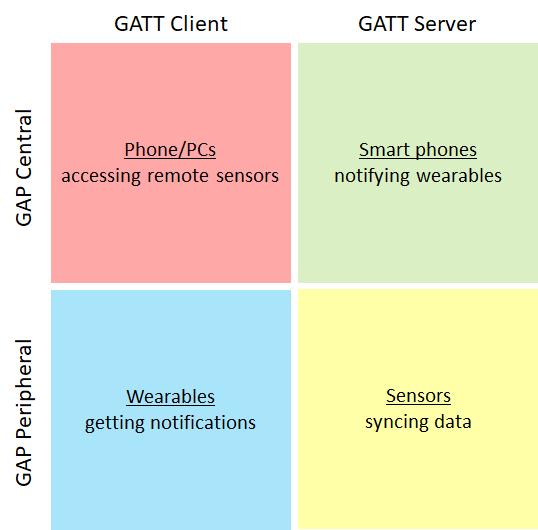Bluetooth Low Energy in Universal Windows Platform apps
This topic provides an overview of Bluetooth LE in Universal Windows Platform (UWP) apps (for more detail about Bluetooth LE, see the Bluetooth Core Specification version 4.0).
Bluetooth Low Energy (LE) is a specification that defines protocols for discovery and communication between power-efficient devices. Discovery of devices is done through the Generic Access Profile (GAP) protocol. After discovery, device-to-device communication is done through the Generic Attribute (GATT) protocol.
 GATT and GAP roles were introduced in Windows 10 version 1703
GATT and GAP roles were introduced in Windows 10 version 1703
GATT and GAP protocols can be implemented in your UWP app by using the following namespaces.
Central and Peripheral
The two primary roles of discovery are called Central and Peripheral. In general, Windows operates in Central mode and connects to various Peripheral devices.
Attributes
A cGeneric Attribute (GATT) Profile defines the structure of data and modes of operation by which two Bluetooth LE devices communicate. The attribute is the main building block of GATT. The main types of attributes are services, characteristics, and descriptors. These attributes perform differently between clients and servers, so it is more useful to discuss their interaction in the relevant sections.
 The heart rate service is expressed in GATT Server API form
The heart rate service is expressed in GATT Server API form
Client and Server
After a connection has been established, the device that contains the data (usually a small IoT sensor or wearable) is known as the Server. The device that uses that data to perform a function is known as the Client. For example, a Windows PC (Client) reads data from a heart rate monitor (Server) to track that a user is working out optimally. For more information, see the GATT Client and GATT Server topics.
Watchers and Publishers (Beacons)
In addition to the Central and Peripheral roles, there are Observer and Broadcaster roles. Broadcasters are commonly referred to as Beacons, they don't communicate over GATT because they use the limited space provided in the Advertisement packet for communication. Similarly, an Observer does not have to establish a connection to receive data, it scans for nearby advertisements. To configure Windows to observe nearby advertisements, use the BluetoothLEAdvertisementWatcher class. In order to broadcast beacon payloads, use the BluetoothLEAdvertisementPublisher class. For more information, see Bluetooth LE Advertisements.
See Also
Feedback
Coming soon: Throughout 2024 we will be phasing out GitHub Issues as the feedback mechanism for content and replacing it with a new feedback system. For more information see: https://aka.ms/ContentUserFeedback.
Submit and view feedback for